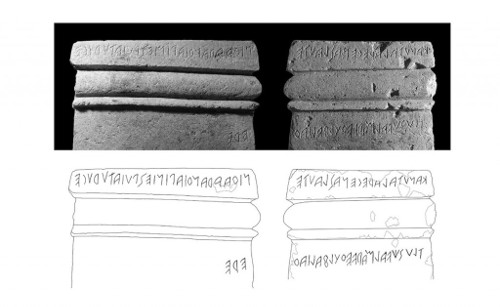Typing Etruscan letters using a Unicode virtual Etruscan keyboard
While the choice was once clearly forced by the actual technical lack of Etruscan typesets, it has been several years since the Unicode Consortium – who is entrusted with the IT standardization of human writing systems – has defined a specific section of the universal character map called Old Italic. The section comprises the letters used by several civilizations of pre-Roman Italy, including the Etruscan alphabet [3].
So, my little very first contribution to Etruscan studies is part of this perspective. It is a Unicode Virtual Etruscan Keyboard – shortly TEVU, from Italian Tastiera Etrusca Virtuale Unicode – which should simplify the transcription of Etruscan texts, allowing to use their original characters. And it aims to be useful also for students of Etruscology, not only for expert Etruscologists. More, using TEVU on a tablet, one can type directly on the screen: just like working with a real keyboard.
Time to see a practical example.
 [1] As a humanist and a classicist, being interested also in Etruscan civilization and language is not new for me. Neither, as a linguist and an IT enthusiast, is the idea of employing computational linguistics to study Etruscan.
[1] As a humanist and a classicist, being interested also in Etruscan civilization and language is not new for me. Neither, as a linguist and an IT enthusiast, is the idea of employing computational linguistics to study Etruscan.
Pages dedicated to Etruscan have been on the internet for years, and both digital and paper epigraphic collections are available. But all of them are sharing a basic flaw: everything is always presented in Latin alphabet. And, of course, this may cause imprecisions and misinterpretations. Just think that the Etruscan alphabet has three different letters whose pronunciation approaches the Latin S [2]. As there is not an univocal accord on their clear phonetic values, linguists may transliterate them as S or SH or even S with more or less arbitrary diacritics, depending on the school.
Systematizing a corpus or a dictionary this way is a really dubious challenge. And actually no languages are studied in transliteration: just to say, it is not done for ancient Greek, it is not done for Russian, it is not done for Chinese and Japanese – which by the way are not even alphabetic languages.
It means that today every web site and software and printed issue – as every book and magazine are computer-designed by now – may reproduce texts in their own writings. More, it means that institutes and scholars have a universal standard basis for networking. A bit as it happens for WordNet based collaborations and projects around the world.
I have chosen three short inscriptions reproduced on the web pages of Rasenna: Journal of the Center for Etruscan Studies, University of Massachusetts Amherst. For each one I am presenting: picture, transcription with TEVU, transliteration and source.

𐌌𐌉 𐌀𐌅𐌉𐌋
mi avil[e]
Murlo Archaeological Museum (Siena), Poggio Civitate id. 1971-0500

𐌌 𐌋𐌀𐌓𐌉𐌔 𐌓𐌉𐌄𐌓𐌕𐌖
m[i] laris riertu
Sarteano Archaeological Museum (Siena), bucchero dish

𐌊𐌀𐌍𐌖𐌕𐌀 𐌋𐌀𐌓𐌄𐌂𐌄𐌍𐌀𐌔 𐌋𐌀𐌖𐌕𐌄𐌍𐌉𐌈𐌀 𐌀𐌓𐌀𐌍𐌈𐌉𐌀 𐌐𐌉𐌍𐌉𐌄𐌔 𐌐𐌖𐌉𐌀 𐌕𐌖𐌓𐌖𐌂𐌄 𐌕𐌋𐌖𐌔𐌙𐌅𐌀𐌋 𐌌𐌀𐌓𐌅𐌄𐌈𐌖𐌋 𐌚𐌀𐌋𐌉𐌀𐌈𐌄𐌓𐌄
kanuta larecenas lautenitha aranthia pinies puia turuce
tluskhval marvethul faliathereInscription found by Simonetta Stopponi in 2008 at Campo della Fiera (Orvieto)
It is evident that a Unicode typeset for Etruscan prevents ambiguous transliterations and, above all, allows to univocally treat Etruscan texts with IT tools for language studies.
Of course, I am aware that in specialist and academic circles the norm is now firmly established to treat Etruscan in transliteration. So, TEVU and my above thoughts might be harshly criticized. Nevertheless, I feel optimistic: the history of knowledge is full of conventions and beliefs that were considered unshakable until someone began to realize they were incorrect. And I am firmly certain that transliterating a language, when it is possible to study it in its own alphabet, is scientifically incorrect.
So, curious Etruscologists and Etruscophiles, feel free to try TEVU and let me know your opinion.
[1] This is the English version of a few short articles I have originally written in Italian: October 2018, October 2019, July 2020, April 2023.
[2] By the way, the more I read the specialistic literature, my opinion is that those three letters are just graphic variants; a bit like what happens with the lowercase Sigma in Greek since the Byzantine age.
[3] As the Old Italic block is left-to-right, I had to design a special font (which I called Rasna Haiku) to let TEVU version 2 (April 2023) type right-to-left.